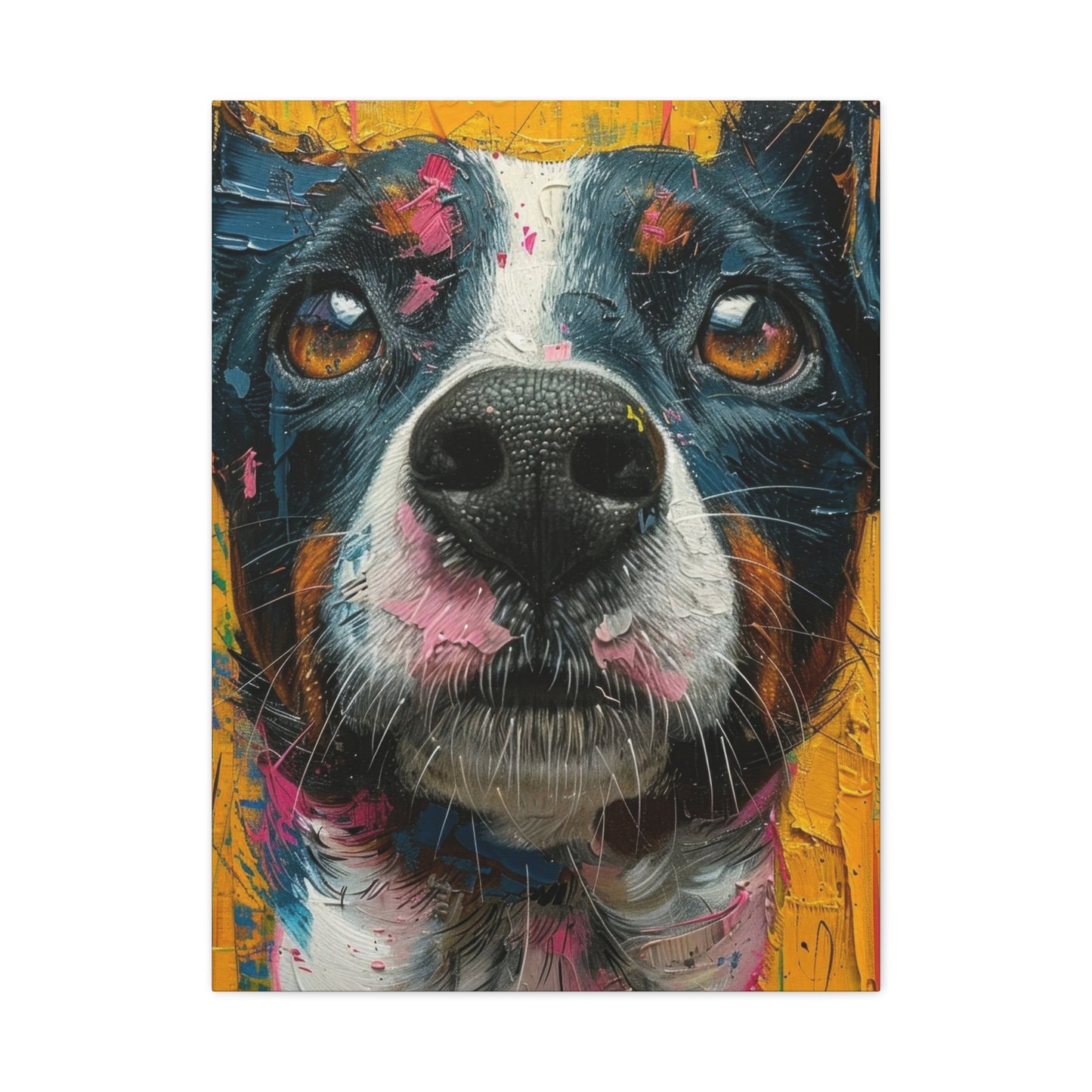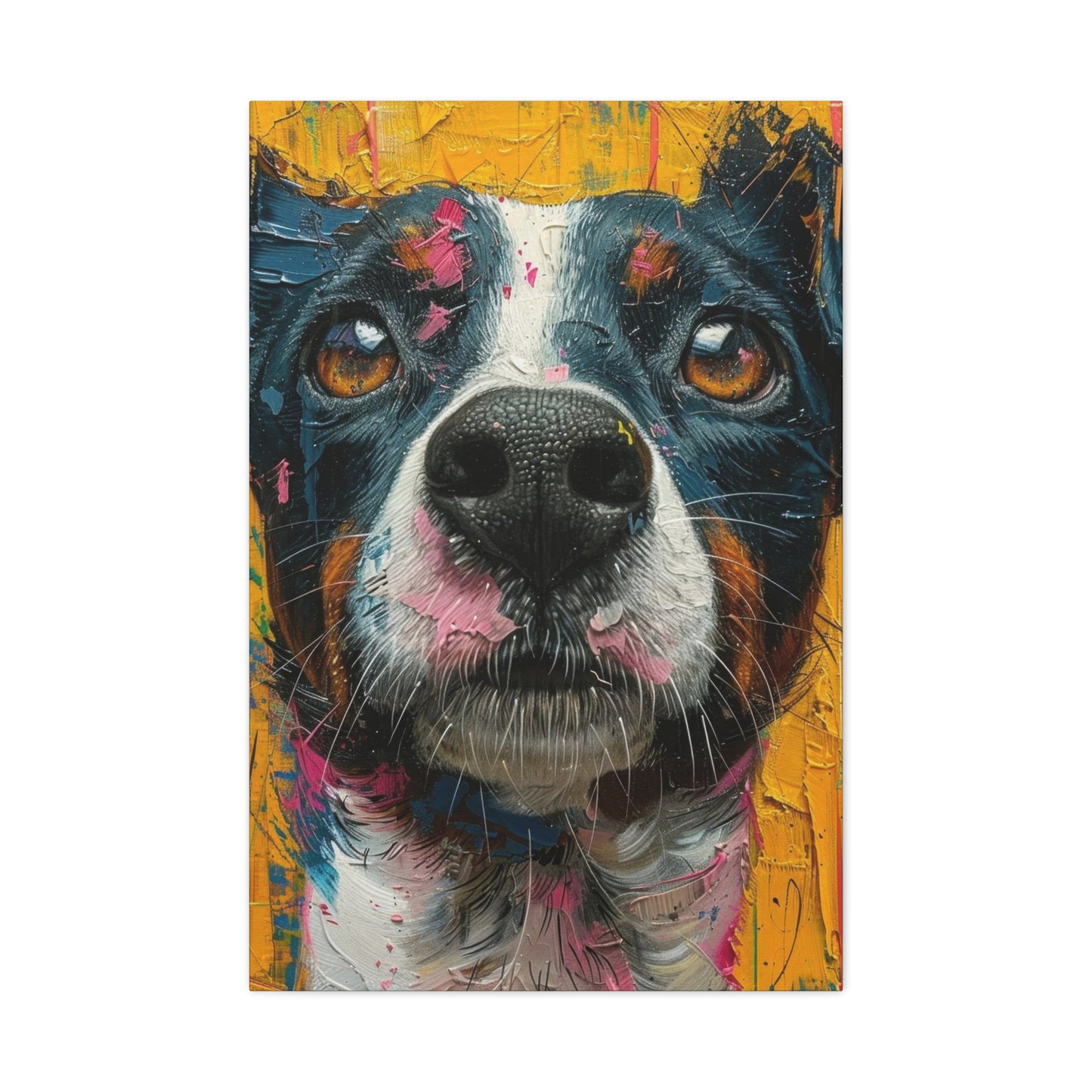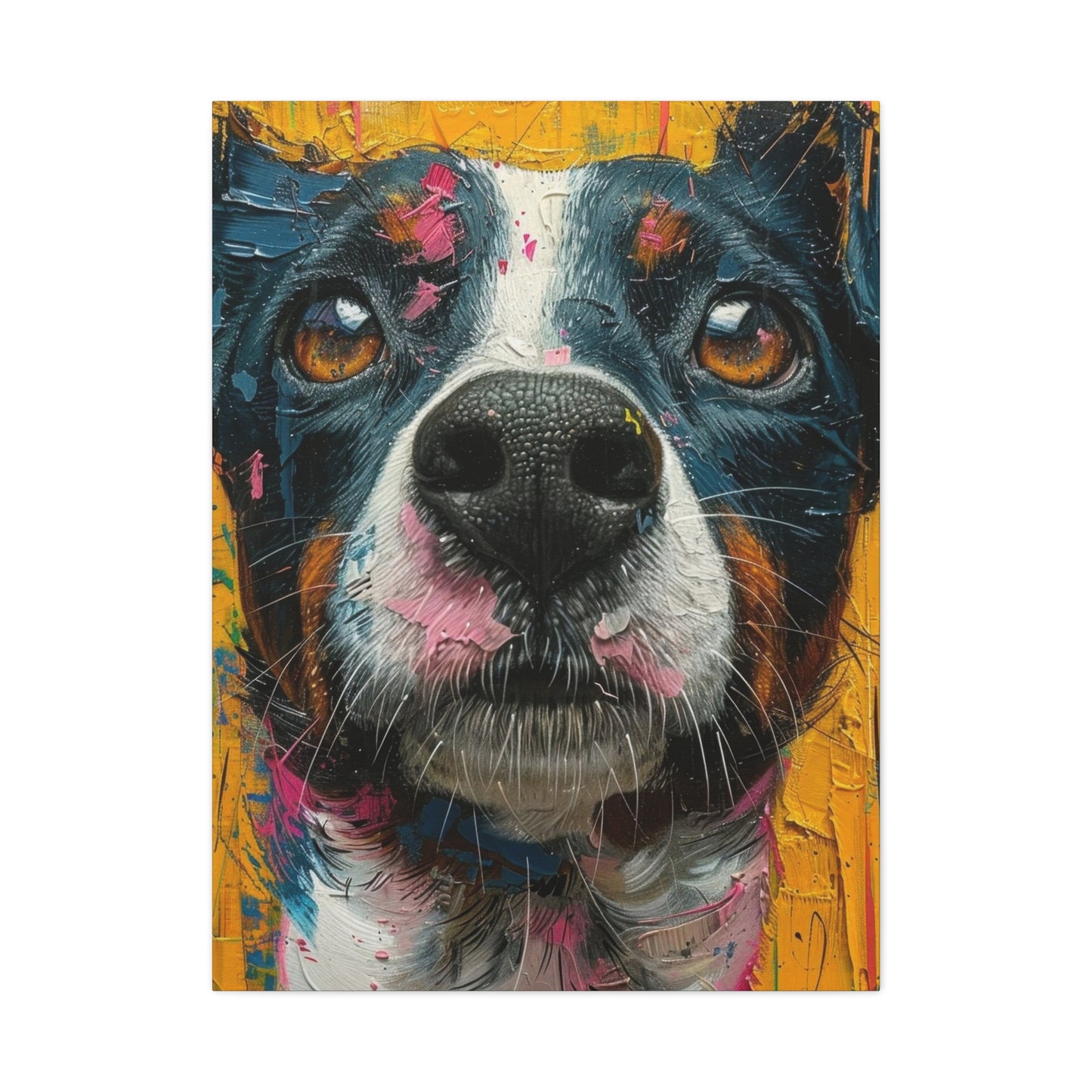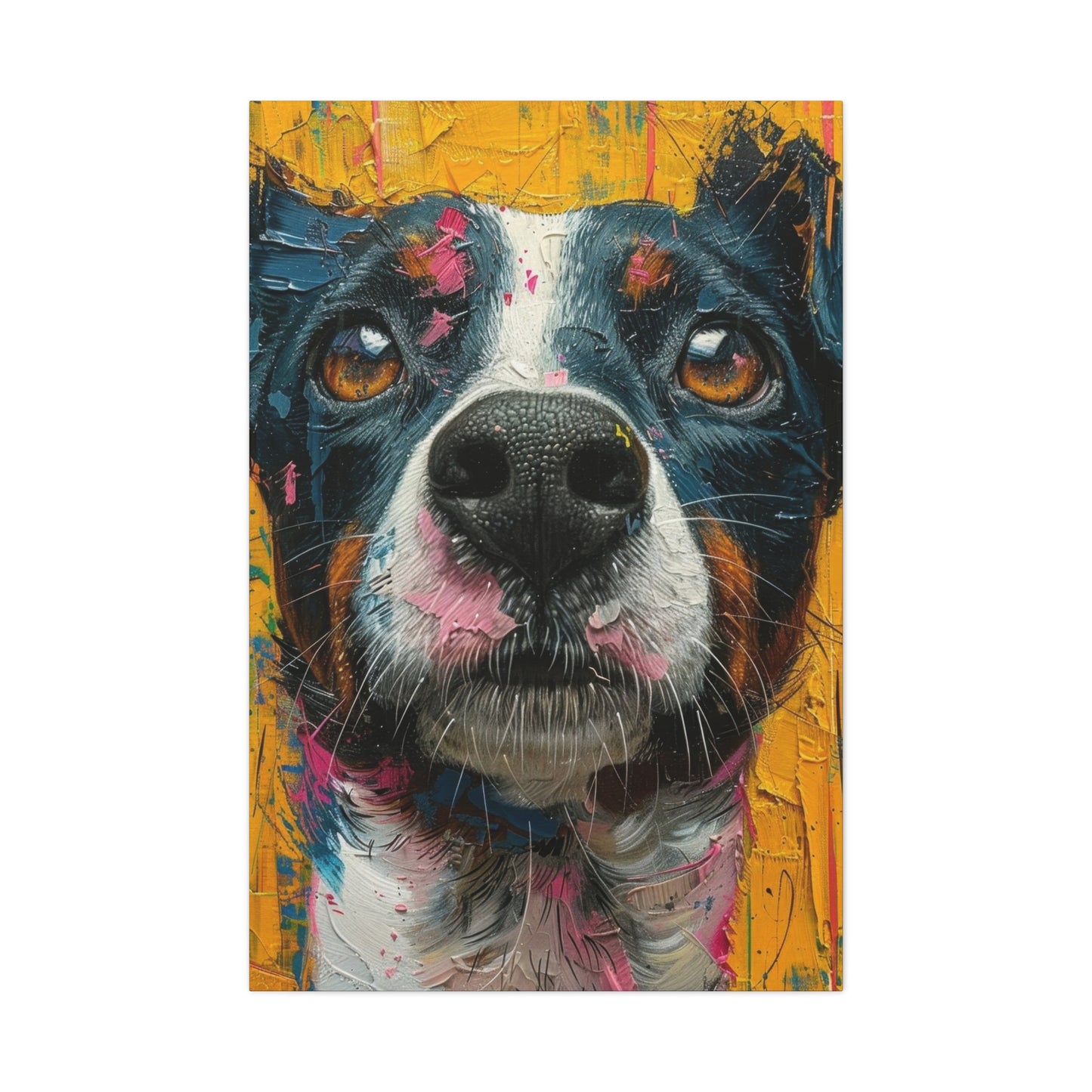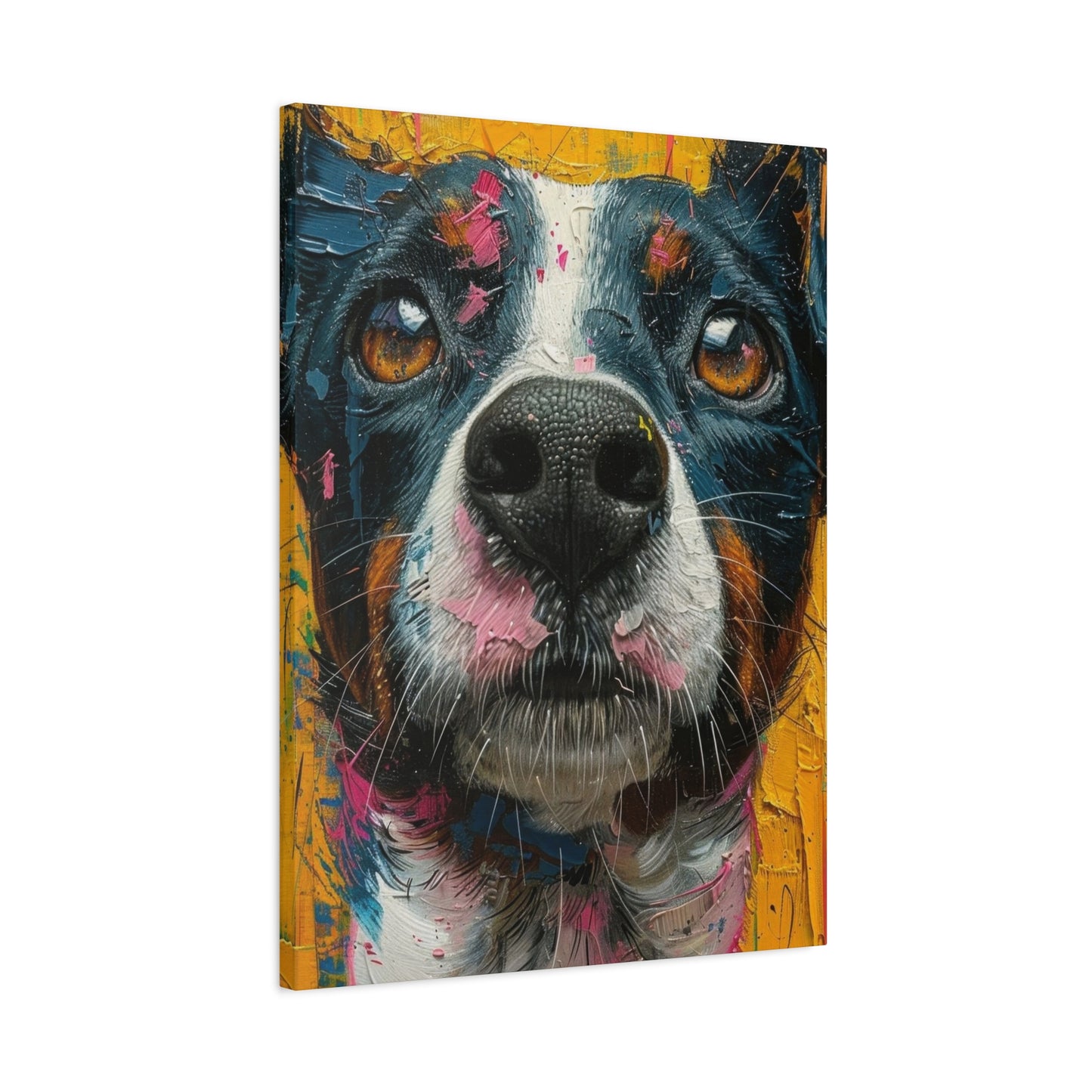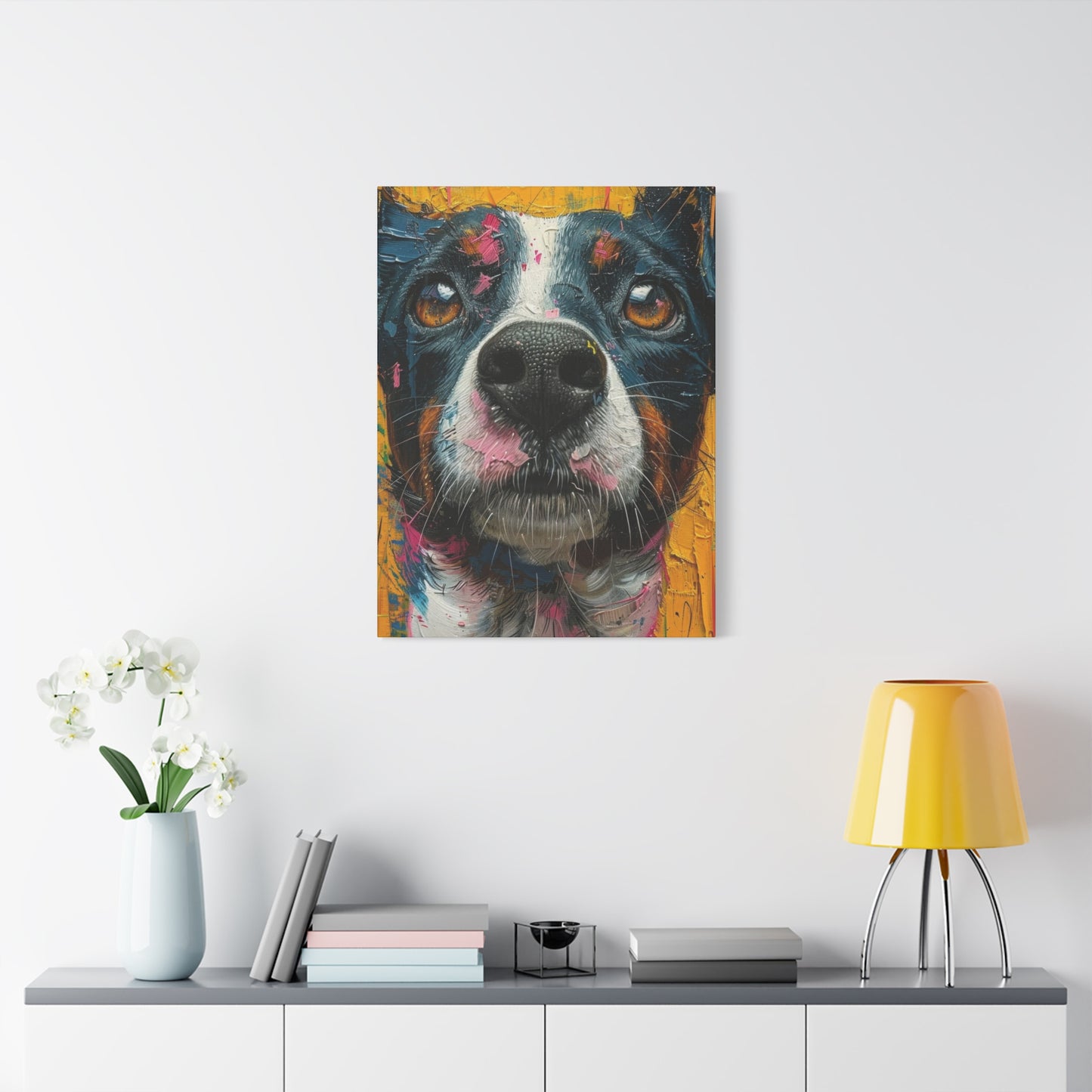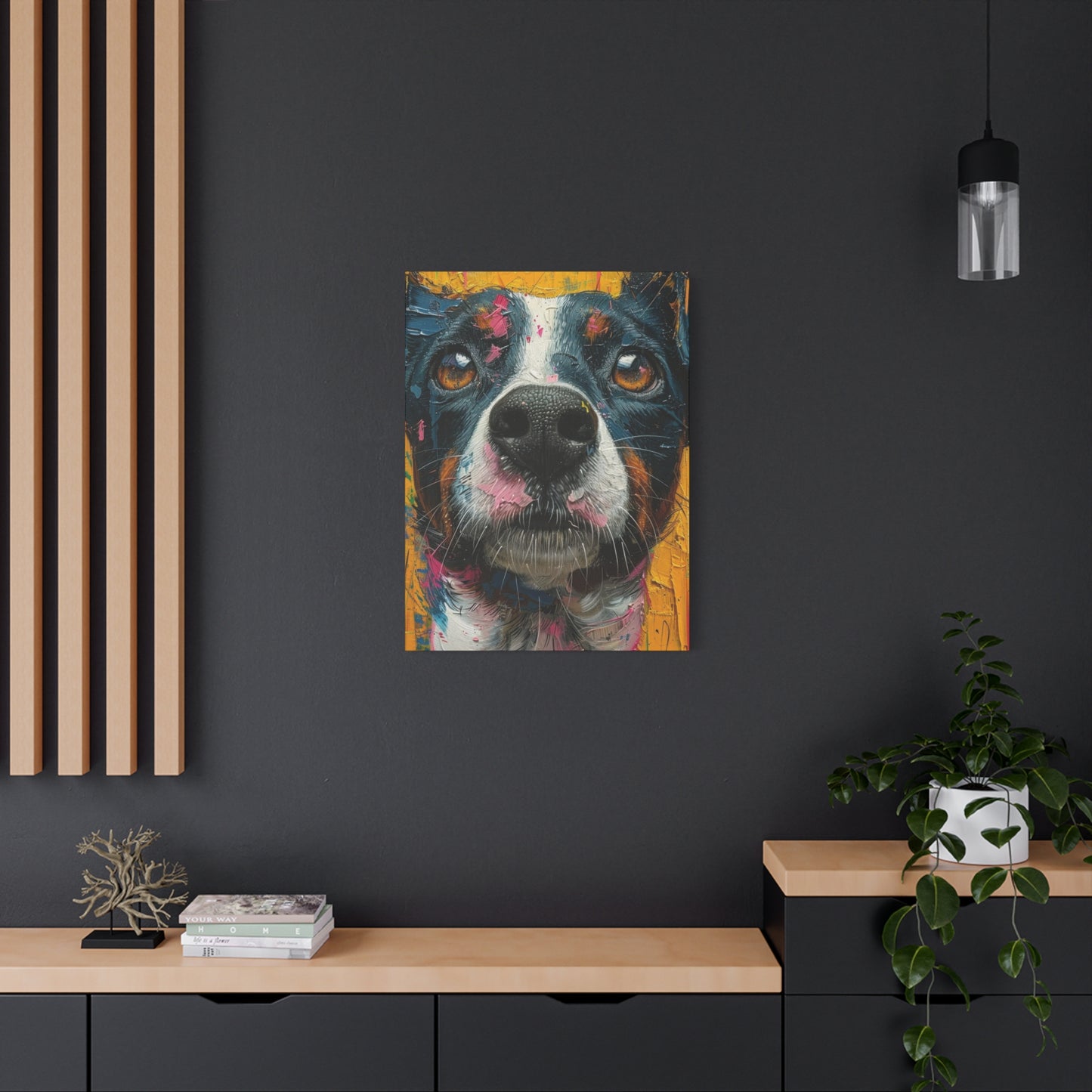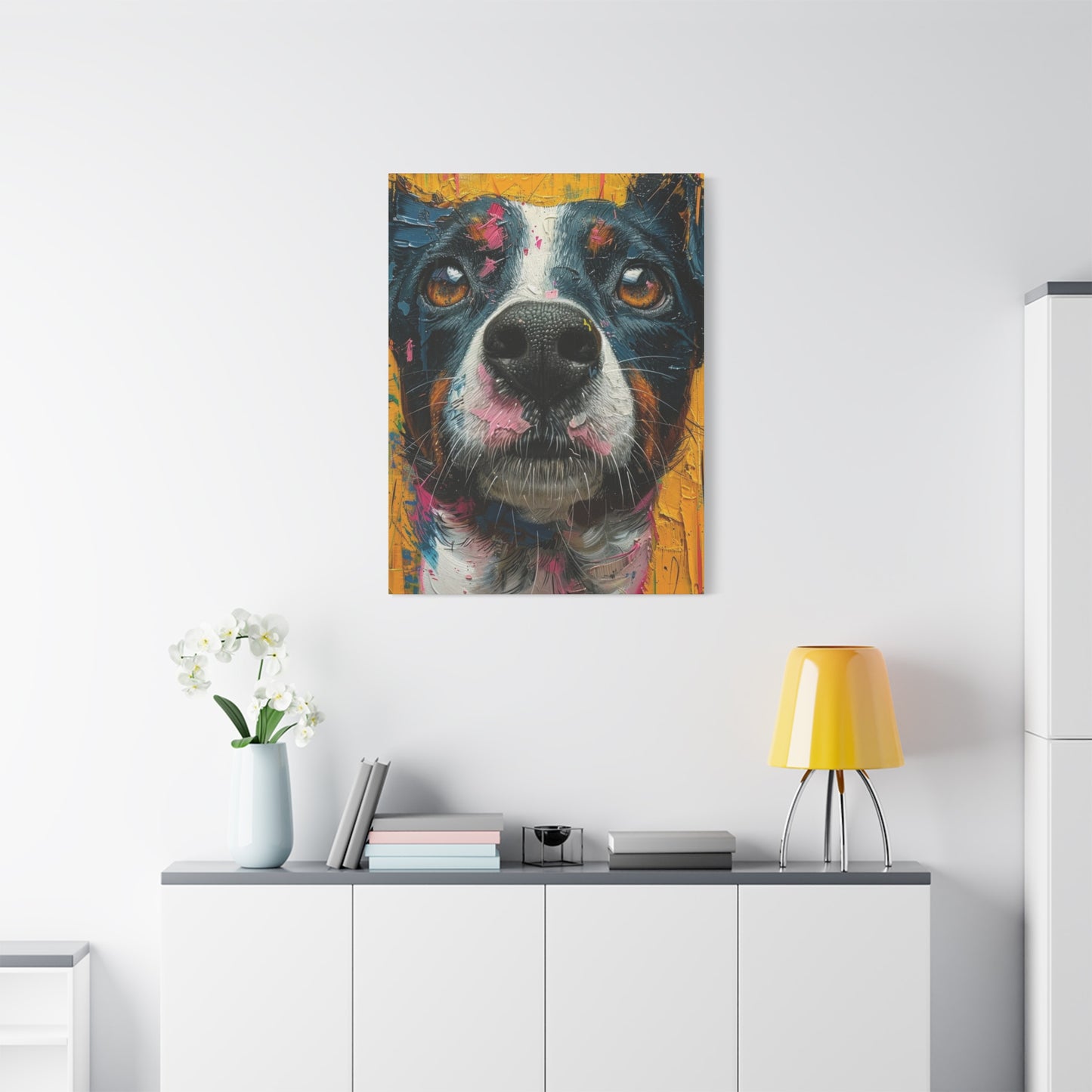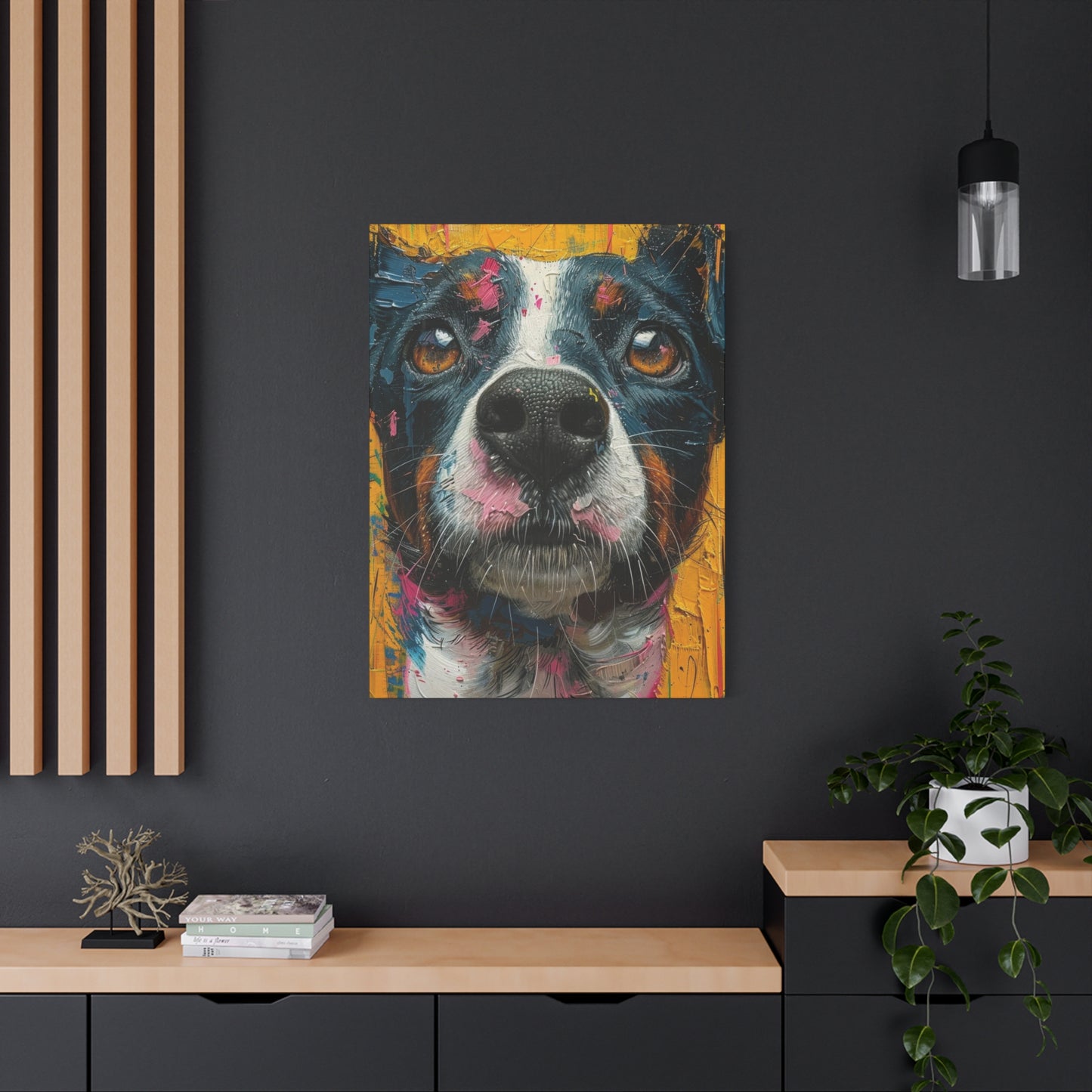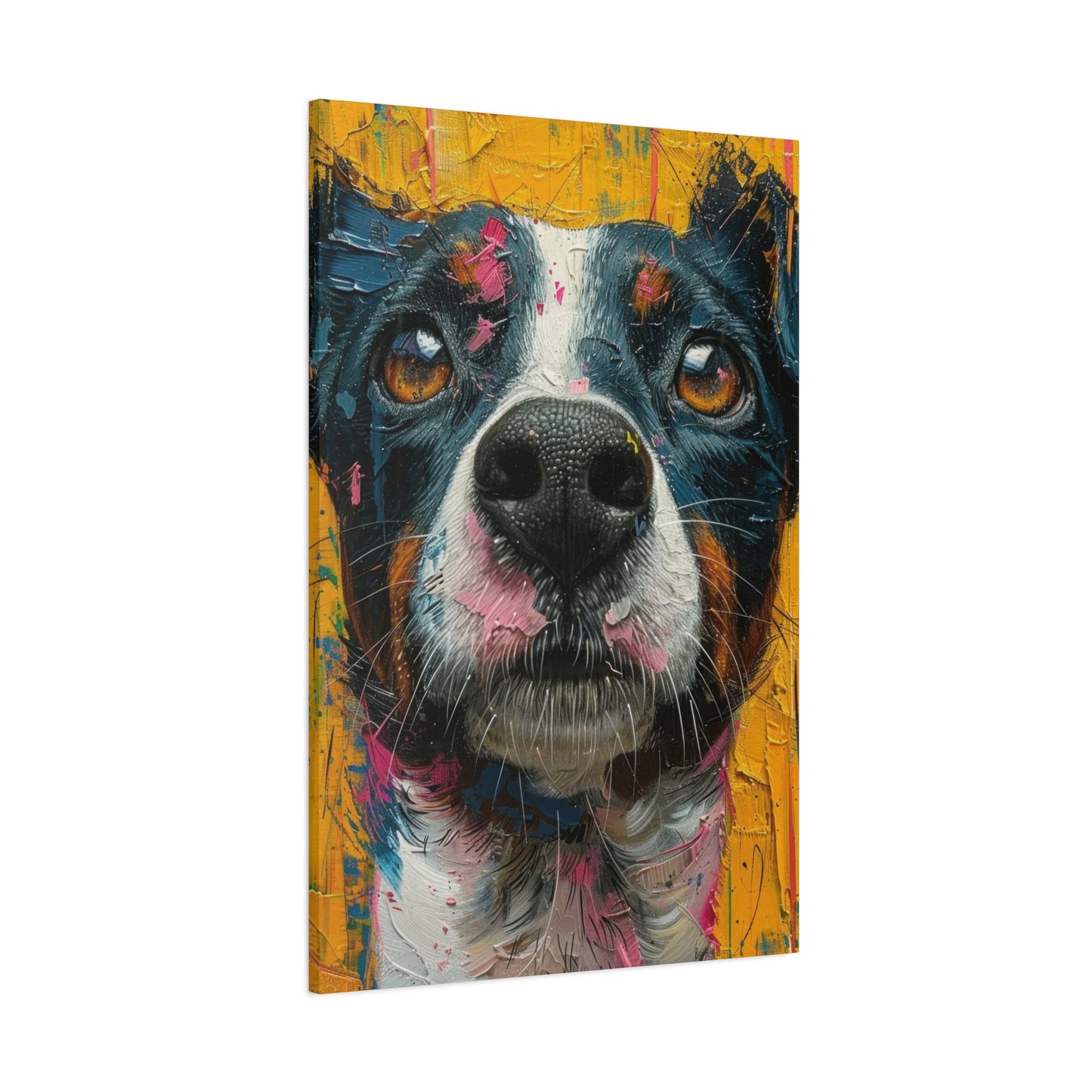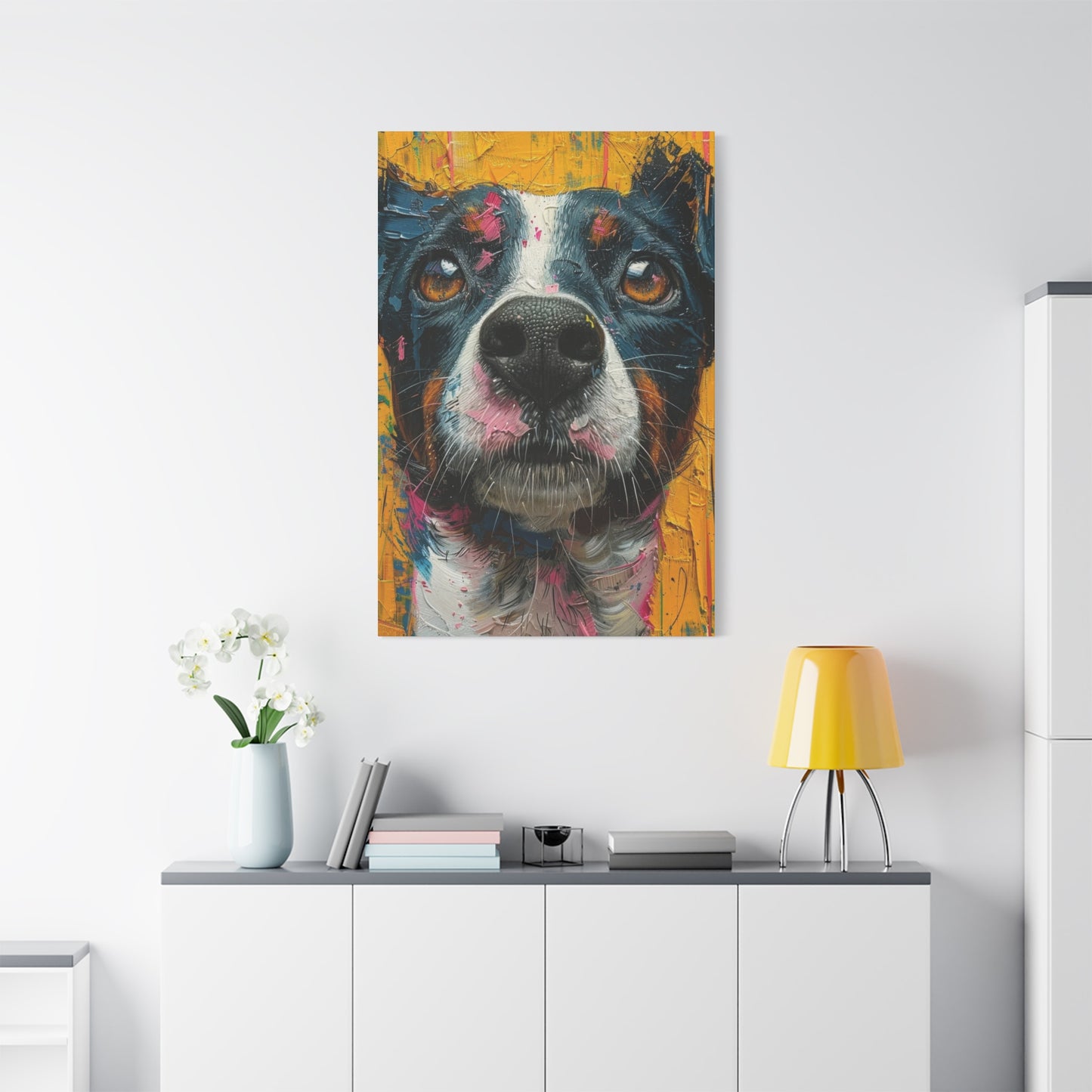Captivating Canine Imagery: Celebrating Dogs Through Closeup Wall Art
The connection between humans and dogs transcends mere companionship, evolving into a profound bond that deserves celebration in our living spaces. When we bring images of our beloved canines into our homes through carefully selected wall art, we create environments that reflect our values, personalities, and the joy these magnificent creatures bring to our lives. The trend of featuring detailed, intimate portrayals of dogs in home décor has experienced remarkable growth, with homeowners and interior designers recognizing the emotional impact and aesthetic value these pieces provide.
Dog face closeup wall art represents more than simple decoration; it embodies the essence of what makes these animals so special to us. The intricate details captured in these artworks reveal the soul behind those trusting eyes, the texture of their fur, and the unique personality traits that make each dog an individual. Whether you're a dedicated dog owner, an animal enthusiast, or someone who appreciates the artistic merit of well-executed animal portraits, incorporating these striking images into your interior design scheme can transform any space into a warm, welcoming environment that speaks to the heart.
This comprehensive exploration delves into the multifaceted world of canine wall art, examining everything from artistic styles and placement strategies to the psychological benefits of surrounding ourselves with images of these faithful companions. We'll navigate through various design approaches, from minimalist interpretations to bold, statement-making pieces that command attention and spark conversation. Understanding how to select, display, and integrate these artworks into your existing décor can elevate your space while honoring the special relationship between humans and their four-legged friends.
Adorable Details: Dog Face Closeup Wall Art
The beauty of canine facial features lies in their remarkable diversity and expressiveness. When captured in closeup format, these details become even more pronounced, revealing the intricate patterns, textures, and nuances that make each dog unique. The fine whiskers catching light, the subtle variations in fur coloration, the delicate structure of ears, and the depth within their gaze all contribute to creating artwork that resonates on an emotional level. These adorable details serve as constant reminders of the joy and unconditional love that dogs bring into our lives, making them perfect subjects for wall art that aims to evoke warmth and positive emotions.
Selecting artwork that emphasizes these charming characteristics requires attention to photographic or artistic quality. High-resolution images or skillfully rendered paintings capture the smallest details, from individual fur strands to the moisture on a nose, creating pieces that appear almost three-dimensional. The technical execution matters significantly because these subtle elements distinguish exceptional artwork from mediocre reproductions. When examining potential pieces, look for clarity in the eyes, realistic texture representation, and balanced composition that draws the viewer's attention to the most compelling features without overwhelming the overall aesthetic.
The emotional response triggered by these detailed portrayals extends beyond simple appreciation of cuteness. Research in environmental psychology suggests that images of beloved animals can reduce stress levels, promote feelings of comfort, and even improve mood throughout the day. When you place such artwork in frequently occupied spaces, you create opportunities for these positive psychological effects to occur naturally and consistently. The adorable details captured in closeup shots serve as visual anchors, providing focal points that offer momentary respites from daily stresses and reconnecting us with simpler, more joyful emotions.
Different dog breeds offer distinct visual characteristics that translate uniquely into wall art. The wrinkled face of a bulldog presents different textural opportunities than the sleek features of a greyhound or the fluffy countenance of a Pomeranian. Understanding these breed-specific traits helps in selecting pieces that align with personal preferences or commemorate specific dogs that hold special meaning. Some collectors choose to create gallery walls featuring various breeds, celebrating the diversity within the species, while others prefer focusing on a single breed that holds particular significance to their personal history or current household composition.
The technical aspects of capturing these adorable details deserve consideration when evaluating artwork quality. Lighting plays a crucial role in revealing texture and dimension, with side-lighting often producing the most dramatic and revealing results. The angle of capture also significantly impacts the final impression, with straight-on shots creating intimate, confrontational engagement, while slightly angled perspectives can convey personality and character more dynamically. Professional photographers and artists understand these technical elements, employing them deliberately to create maximum emotional impact and visual interest in their final compositions.
Expressive Eyes: Closeup Dog Portraits on Canvas
The eyes of a dog serve as windows into their emotional world, conveying trust, intelligence, playfulness, and devotion with remarkable clarity. When artists and photographers focus on capturing these expressive features in closeup format, they create powerful visual statements that connect with viewers on a primal, emotional level. Canvas reproductions of these portraits offer particular advantages, providing texture and depth that enhance the viewing experience while maintaining durability and longevity. The slight grain of canvas material adds an artistic quality that complements the subject matter, bridging the gap between photography and traditional painting.
Creating effective eye-focused portraits requires technical expertise and artistic sensibility. The catchlight—that small reflection of light source visible in the eye—brings life and vitality to the image, transforming a static representation into something that seems to breathe and respond. Professional artists and photographers carefully orchestrate lighting conditions to achieve this effect naturally, understanding that artificial enhancement rarely produces the same authentic quality. The surrounding facial features frame these expressive eyes, with the positioning of ears, the set of the mouth, and the overall head angle all contributing to the emotional narrative conveyed through the piece.
Canvas as a medium offers distinct benefits for dog portrait presentation. The material's texture adds visual interest without distracting from the subject, creating a traditional fine art appearance that elevates the perceived value and artistic merit of the piece. Canvas prints stretched over wooden frames provide three-dimensional presence, casting subtle shadows that enhance their physical impact on wall space. The durability of properly prepared canvas ensures these cherished images remain vibrant and intact for years, resisting fading, warping, and damage better than paper-based alternatives when properly cared for and displayed away from direct sunlight and excessive moisture.
The color palette surrounding expressive eyes significantly influences the overall mood and impact of the artwork. Warm tones—browns, golds, and ambers—create feelings of comfort and nostalgia, while cooler palettes featuring grays and blues can evoke sophistication and contemporary styling. The background treatment also matters considerably; softly blurred backgrounds direct attention to the eyes and facial features, employing the photographic technique of shallow depth of field to create natural visual hierarchy. Alternatively, solid color backgrounds offer minimalist appeal, allowing the dog's features to stand independently without competing visual elements.
Displaying eye-focused portraits requires thoughtful placement to maximize their emotional impact. These pieces work exceptionally well at eye level in spaces where viewers can engage with them directly and intimately. Hallways, bedroom walls, and personal office spaces serve as ideal locations, creating opportunities for repeated, meaningful viewing experiences. The size of the canvas should correspond to the viewing distance and available wall space, with larger formats suitable for spacious rooms where viewers stand farther away, and more modest dimensions appropriate for smaller, more intimate environments where close viewing occurs naturally.
Minimalist Pet Art: Dog Face Closeup Prints
The minimalist approach to canine artwork strips away unnecessary elements, focusing attention on essential forms, lines, and expressions that define the subject. This design philosophy aligns perfectly with contemporary interior trends that emphasize clean lines, uncluttered spaces, and intentional decoration choices. Dog face closeup prints executed in minimalist style often employ limited color palettes, simple backgrounds, and careful composition that highlights the most compelling aspects of canine features without overwhelming viewers with excessive detail or visual complexity.
Creating successful minimalist pet art requires discipline and artistic restraint. The challenge lies in determining which elements to retain and which to eliminate, preserving enough detail to maintain recognizability and emotional connection while achieving the simplicity that defines minimalist aesthetics. Artists working in this style often employ techniques like high-contrast black and white rendering, selective focus that blurs peripheral details, or simplified color blocking that reduces complex fur patterns to their essential chromatic components. These approaches result in artwork that feels modern, sophisticated, and timeless rather than trendy or dated.
The psychological impact of minimalist design extends to the artwork displayed within these spaces. Research suggests that environments with reduced visual clutter promote mental clarity, reduce anxiety, and enhance focus. When you incorporate minimalist dog portraits into such spaces, you maintain these beneficial effects while adding warmth and personality that purely abstract or geometric art cannot provide. The emotional connection to the animal subject prevents the space from feeling cold or impersonal, striking a balance between aesthetic restraint and human warmth that characterizes the most successful contemporary interiors.
Print quality assumes critical importance in minimalist artwork where fewer elements exist to distract from technical imperfections. Sharp edges, accurate color reproduction, and proper contrast become immediately apparent in simplified compositions. Professional printing processes using archival inks and quality paper or canvas substrates ensure these technical standards are met, producing pieces that maintain their visual integrity over extended periods. The mounting and framing choices should complement the minimalist aesthetic, with simple, clean-lined frames or frameless mounting techniques that allow the artwork itself to remain the primary focus without ornate borders competing for attention.
Incorporating minimalist dog prints into various room styles requires consideration of existing design elements. In Scandinavian-inspired spaces characterized by light woods, white walls, and natural textures, black and white or softly colored dog portraits maintain the overall aesthetic while adding focal interest. Mid-century modern environments benefit from prints featuring bold, simplified forms and limited color palettes that echo the period's graphic sensibilities. Even in more eclectic spaces, minimalist dog art can serve as a calming visual anchor, providing respite from surrounding complexity while contributing to the overall personality of the room.
Statement Pieces: Bold Dog Face Wall Art
Statement artwork commands attention, transforming ordinary walls into conversation starters and defining the character of entire rooms. Bold dog face wall art achieves this impact through various means: exceptional size, striking color palettes, unusual perspectives, or dramatic contrast that makes the piece impossible to ignore. These artworks don't simply decorate spaces; they dominate them in the best possible way, creating focal points around which other design elements naturally organize themselves. Selecting such powerful pieces requires confidence and commitment, as they will significantly influence the room's overall aesthetic and emotional atmosphere.
Size represents the most straightforward approach to creating statement impact. Large-format dog portraits measuring four feet or more in any dimension immediately establish visual dominance, particularly when displayed on otherwise unadorned walls. The scale allows viewers to perceive details impossible to appreciate in smaller formats, creating immersive experiences where you feel almost confronted by the subject's presence. This intimacy can be powerful and moving, especially when the dog's expression conveys particular emotion or personality. The installation of such large pieces requires proper mounting systems capable of supporting their weight safely, with professional installation often recommended to ensure security and optimal positioning.
Color intensity and contrast create another path to statement impact. Vibrant, saturated hues or bold black and white treatments transform ordinary dog portraits into dynamic visual experiences. Artists sometimes employ unconventional color choices, rendering familiar subjects in unexpected palettes that challenge perceptions while maintaining recognizability. These chromatic decisions can complement existing color schemes by echoing accent colors present in furnishings and accessories, or they can introduce entirely new color families that shift the room's overall palette. The psychological effects of color cannot be overstated, with warm tones promoting energy and social interaction, while cooler colors encourage relaxation and contemplation.
Unusual perspectives and compositional choices distinguish memorable statement pieces from conventional portraits. Extreme closeups that crop aggressively, showing only a portion of the face or featuring a single eye in oversized detail, create arresting images that subvert expectations. Unexpected angles, such as overhead or ground-level views, present familiar subjects in unfamiliar ways, engaging viewers' curiosity and prompting longer observation. These artistic decisions demonstrate creativity and intentionality, signaling that the artwork represents a considered artistic statement rather than merely decorative filler.
Integrating bold statement pieces into existing décor requires balancing their dominance with surrounding elements. The artwork should enhance rather than overwhelm the space, which paradoxically means ensuring other elements maintain appropriate restraint. When a powerful dog portrait serves as the room's focal point, furniture arrangements should orient toward it, lighting should illuminate it effectively, and surrounding wall decorations should either complement it subtly or be absent entirely. This doesn't mean the entire room must be designed around the artwork, but rather that the piece's prominent position should be acknowledged and respected through thoughtful spatial planning.
Realistic Canine Portraits for Living Rooms
Living rooms serve as primary gathering spaces where families congregate, guests are entertained, and significant time is spent in relaxation and social interaction. The artwork displayed in these important spaces contributes significantly to the atmosphere and impression created, making the selection of realistic canine portraits a decision worthy of careful consideration. Realism in pet portraiture aims to capture subjects with photographic accuracy, rendering fur texture, eye detail, and facial expressions with meticulous precision. These technically accomplished pieces appeal to viewers who appreciate artistic skill and craftsmanship while honoring the genuine appearance of beloved animal subjects.
The creation of truly realistic dog portraits requires exceptional artistic ability and patience. Traditional painters working in oils or acrylics build up layers of color and detail over extended periods, carefully observing how light interacts with fur, how shadows define form, and how subtle color variations create the illusion of depth and dimension. Contemporary digital artists employ sophisticated software and stylus-based drawing tablets to achieve similar results through different means, often combining photographic references with hand-applied brushwork that adds artistic interpretation to technical accuracy. Both approaches can produce stunning results when executed by skilled practitioners who understand canine anatomy and expression.
Selecting appropriately sized realistic portraits for living room display depends on several factors including wall dimensions, furniture scale, and viewing distances. Larger living rooms with high ceilings can accommodate oversized portraits that might overwhelm smaller spaces, while more modest rooms benefit from medium-sized pieces that provide presence without dominating. The artwork should relate proportionally to furniture pieces, particularly sofas and entertainment centers that often anchor living room layouts. A general guideline suggests artwork should span approximately two-thirds to three-quarters the width of furniture pieces it hangs above, though this rule can be adjusted based on specific circumstances and design preferences.
Framing choices significantly impact how realistic dog portraits integrate into living room aesthetics. Traditional ornate frames suit formal, classic interiors furnished with antiques and rich materials, while simple, modern frames better complement contemporary spaces featuring clean lines and minimal ornamentation. The frame color should coordinate with existing wood tones in furniture and trim, or provide intentional contrast when that effect is desired. Mat boards create visual breathing room around the artwork, preventing the image from feeling cramped within its frame, though frameless mounting or gallery wraps present alternatives for more contemporary presentations.
Lighting considerations ensure realistic portraits display optimally in living room environments. Natural daylight should be controlled to prevent direct sunlight from striking the artwork, as ultraviolet radiation causes fading over time and glare can obscure details during certain times of day. Artificial lighting supplements or replaces natural light, with picture lights, track lighting, or strategically placed floor and table lamps all offering viable solutions. The color temperature of bulbs affects how colors appear, with warm white bulbs enhancing traditional interiors and cooler daylight bulbs suiting contemporary spaces. Proper illumination not only protects the artwork but also ensures the careful details that define realistic portraits remain visible and appreciable throughout various times of day and lighting conditions.
Closeup Canine Expressions: Wall Art Ideas
The remarkable range of emotions that dogs display through facial expressions provides endless inspiration for compelling wall art. From joyful exuberance to contemplative calmness, from playful mischief to loyal devotion, these expressions communicate across species boundaries, creating immediate emotional connections with human viewers. Artwork that captures these varied expressions offers opportunities to set specific moods within spaces, with energetic, happy expressions bringing vitality to active areas, while serene, peaceful faces promote relaxation in quiet zones. Understanding how different expressions impact room atmosphere enables more intentional, effective decoration choices.
Creating gallery walls featuring multiple canine expressions represents one popular approach to this artwork category. By assembling several pieces showing dogs displaying various emotions, you create visual narratives that engage viewers through diversity and comparison. The individual pieces should maintain some unifying elements—perhaps similar sizes, consistent framing, or coordinated color palettes—while showcasing different expressions and possibly different breeds. This approach works particularly well in hallways, stairwells, or large wall expanses in family rooms where space allows for multiple pieces without creating visual clutter.
The technical capture of genuine canine expressions requires patience and skill from photographers and artists. Dogs cannot be directed like human models, making candid photography or extensive observation sessions necessary to capture authentic moments of emotion. Professional animal photographers develop techniques for encouraging desired behaviors, using sounds, movements, and rewards to elicit reactions while remaining ready to capture fleeting expressions that appear spontaneously. Artists working from photographs or life studies must carefully observe and render the subtle muscle movements, eye positions, and ear placements that distinguish one expression from another, understanding that small details dramatically affect the emotional reading of the final artwork.
Different rooms and functional spaces benefit from particular expressions in their wall art. Home offices and studies suit portraits showing intelligence and focus, with dogs appearing alert and engaged, conveying professionalism and competence. Bedrooms benefit from calm, peaceful expressions that promote relaxation and rest, with softly gazing eyes and relaxed facial features contributing to tranquil atmospheres. Children's rooms delight in playful, energetic expressions that match youthful energy levels and celebrate fun and imagination. Dining areas and kitchens can handle more varied expressions, though joyful, welcoming faces tend to complement the social nature of these spaces most effectively.
Abstract or artistic interpretations of canine expressions offer alternatives to strictly realistic representations. Some artists employ impressionistic techniques, suggesting expressions through loose brushwork and color choices rather than precise detail. Others use graphic approaches, reducing expressions to simplified lines and shapes that capture essence rather than specifics. These stylized interpretations can feel more contemporary and artistic than straightforward realism, appealing to collectors who value creative interpretation alongside recognizable subject matter. The choice between realistic and stylized expression portraits depends on personal preference, existing décor style, and the desired impact of the artwork within its display environment.
Cozy Interiors: Dog Face Canvas for Bedrooms
Bedrooms serve as personal sanctuaries where we begin and end each day, making the décor choices for these intimate spaces particularly significant. Dog face canvas artwork brings warmth, comfort, and positive emotional associations into bedroom environments, contributing to atmospheres conducive to relaxation and restorative sleep. The presence of beloved animal imagery can reduce stress, promote feelings of security, and create emotional continuity with the positive relationships we maintain with our canine companions. Selecting appropriate pieces for bedroom display requires consideration of personal taste, existing color schemes, and the specific emotional tone desired for this most private of spaces.
The positioning of dog portraits within bedroom layouts deserves thoughtful planning. Above the bed represents the most traditional and prominent placement, creating a focal point visible upon entering the room and providing pleasant imagery for contemplation during quiet moments. However, this location isn't suitable for all pieces, particularly large or heavy canvases that pose potential safety concerns. Alternative locations include opposite the bed, providing something beautiful to view upon waking, or on walls adjacent to seating areas, reading nooks, or vanity stations where time is spent in focused activities. The viewing angle and distance from typical positions within the room should inform both placement and artwork size selection.
Color coordination between dog portrait canvas and bedroom textiles enhances overall design coherence. When bedding, curtains, and wall colors harmonize with tones present in the artwork, the room feels intentionally designed rather than haphazardly assembled. This doesn't require exact matching but rather thoughtful complementarity, with accent colors from the portrait echoed in throw pillows, blankets, or area rugs. Neutral-toned dog portraits offer maximum flexibility, working with virtually any color scheme, while more vibrant pieces may inspire partial room redesigns that incorporate their distinctive palettes throughout the space.
The emotional quality conveyed through selected dog portraits significantly impacts bedroom atmosphere. Calm, peaceful expressions with soft gazes and relaxed features promote tranquility appropriate for sleeping spaces. Overly energetic or intense expressions might prove stimulating rather than soothing, potentially interfering with the relaxation necessary for quality sleep. This consideration becomes particularly relevant for individuals who experience sleep difficulties or anxiety, as environmental factors including visual stimuli demonstrably affect sleep quality. Selecting imagery that evokes positive, gentle emotions contributes to creating bedroom environments that support rather than hinder healthy sleep patterns.
Lighting design for bedroom dog portraits requires special attention to functionality and ambiance. During evening hours, harsh overhead lighting can create unwelcome glare on canvas surfaces while failing to provide the soft, relaxing illumination bedrooms require. Wall sconces positioned above or beside artwork, table lamps with adjustable brightness, or LED strip lighting behind the canvas can provide gentle illumination that showcases the portrait while contributing to overall room ambiance. Dimmer switches allow lighting intensity adjustment throughout the day and evening, supporting various activities from reading to winding down for sleep. The lighting solutions should enhance rather than overpower the artwork, maintaining the cozy, intimate atmosphere that defines successful bedroom design.
Artistic Pet Portraits: Dog Face Closeup Prints
The intersection of fine art and pet imagery has evolved significantly, with contemporary artists bringing sophisticated techniques and creative visions to animal subjects once dismissed as merely sentimental. Artistic dog face closeup prints represent this elevated approach, incorporating elements like bold brushwork, unexpected color choices, textural experimentation, and compositional innovation that distinguish them from straightforward photographs or traditional portraits. These pieces appeal to art enthusiasts who appreciate technical skill and creative vision while maintaining affection for canine subjects that make the artwork personally meaningful beyond purely aesthetic considerations.
Various artistic movements and styles influence contemporary dog portrait creation. Impressionistic approaches employ visible brushstrokes and light-focused compositions that capture the essence and mood of subjects rather than precise details. Abstract interpretations reduce dog faces to fundamental shapes, colors, and patterns, requiring viewers to engage more actively in recognizing and interpreting the subject. Pop art influences manifest in bold colors, graphic treatments, and repetitive compositions reminiscent of Warhol's celebrity portraits but featuring beloved pets instead of human personalities. Understanding these artistic approaches helps collectors identify styles that resonate personally and complement existing art collections and interior design schemes.
The materials and printing processes used in creating artistic dog prints affect both appearance and longevity. Giclée printing represents the highest quality reproduction method, using archival inks and professional-grade printers to produce gallery-quality prints virtually indistinguishable from original artwork. These prints resist fading and maintain color accuracy over decades when properly displayed and cared for. Alternative processes like screen printing, lithography, or digital prints on various substrates each offer different aesthetic qualities and price points, allowing collectors to select options matching their budgets and preferences while understanding the tradeoffs involved in different reproduction methods.
Collecting artistic dog portraits can evolve into a sophisticated hobby connecting enthusiasts with emerging and established artists. Limited edition prints, signed and numbered by artists, maintain value better than open edition reproductions and offer collectibility beyond mere decoration. Following particular artists through social media, galleries, and online platforms allows collectors to acquire works from favored creators while potentially benefiting from increased valuations as artists' reputations grow. Building curated collections around specific styles, artistic movements, or featured breeds creates coherent assemblages that tell personal stories while demonstrating educated taste and appreciation for contemporary animal art.
Displaying artistic dog prints within gallery walls or dedicated art spaces elevates their status from mere decoration to serious collection pieces. Consistent framing across multiple pieces creates visual unity while allowing individual artworks to maintain distinct identities. Arrangement patterns might follow formal grids for contemporary symmetry or employ organic salon-style hanging for more relaxed, collected-over-time aesthetics. The background wall color significantly impacts how artwork reads visually, with white walls providing neutral showcases, gray walls adding sophistication, and colored walls creating dynamic interactions with artwork tones. Proper spacing between pieces prevents overcrowding while maintaining visual relationships that connect individual works into cohesive displays.
Wildlife at Home: Dogs Captured on Canvas
The domestication of dogs represents one of humanity's longest and most successful interspecies partnerships, yet these animals retain connections to their wild ancestors that occasionally surface in behavior, instinct, and appearance. Artwork that captures dogs with the same respect and artistic approach traditionally reserved for wildlife photography and painting acknowledges these connections, presenting familiar companions through lenses typically focused on wolves, foxes, and other wild canids. This perspective creates compelling visual experiences that honor dogs as both beloved pets and remarkable animals deserving appreciation independent of their utility to humans.
Photographic techniques borrowed from wildlife documentation enhance dog portraiture considerably. Using natural lighting conditions, capturing subjects in outdoor environments, employing longer focal length lenses that compress perspective and isolate subjects from backgrounds, and waiting patiently for authentic behavioral moments all contribute to creating images that feel discovered rather than staged. These approaches result in artwork with different qualities than studio portraits, often conveying more personality, vitality, and natural behavior that viewers find engaging and authentic. The connection to nature implicit in these images can bring elements of the outdoors into indoor spaces, particularly beneficial in urban environments where access to natural settings may be limited.
The composition and framing choices that distinguish wildlife photography translate effectively to dog subjects. Tight crops focusing on facial features, particularly eyes, create intimacy and emotional connection. Environmental portraits that include natural settings like forests, fields, or waterside locations situate dogs within contexts that emphasize their animal nature rather than their domestic roles. Action shots capturing movement—running, jumping, swimming—demonstrate physical capabilities and instinctive behaviors that connect contemporary dogs to their evolutionary heritage. These varied approaches offer alternatives to static, posed portraits, expanding the visual vocabulary available for canine wall art.
Different dog breeds exhibit varying degrees of wild appearance, with some maintaining features closely resembling their wolf ancestors while others have been bred into forms quite distant from wild canids. Breeds like Siberian Huskies, Alaskan Malamutes, and German Shepherds translate particularly well into wildlife-style portraiture, their features and proportions echoing wild relatives in ways that feel natural and appropriate. However, even breeds with more divergent appearances can benefit from wildlife photography approaches, the techniques bringing out inherent animal qualities that exist regardless of physical resemblance to wolves or foxes. The key lies in respecting the subject as an animal first, companion second, at least within the artistic frame.
Creating cohesive interior designs that incorporate wildlife-style dog artwork requires consideration of complementary elements. Natural materials like wood, stone, and plant fiber textiles harmonize with the organic qualities of these images, creating environments that feel grounded and connected to nature. Earth tone color palettes in browns, greens, and neutral tones support the natural aesthetic while avoiding conflict with the outdoor settings often featured in wildlife-style dog photography. However, these pieces can also create striking contrasts within more contemporary, minimalist interiors, their organic qualities providing warmth and life to spaces that might otherwise feel stark or impersonal.
Modern Pet Art: Dog Face Wall Décor
Contemporary approaches to canine artwork reflect current design trends while pushing creative boundaries in technique, presentation, and conceptualization. Modern pet art encompasses diverse expressions from digital manipulations and graphic designs to mixed media explorations and unconventional materials. These innovative approaches appeal to design-forward individuals who appreciate art that reflects current cultural moments while maintaining personal relevance through beloved pet subjects. Understanding what defines modern pet art helps collectors navigate this dynamic category and select pieces that will maintain relevance and appeal as trends continue evolving.
Digital artistry has revolutionized pet portrait creation, enabling effects and styles impossible or impractical through traditional media. Artists use sophisticated software to create illustrations that combine photorealism with fantastical elements, placing dogs in imaginary environments or adorning them with creative embellishments. Vector-based graphics reduce dogs to clean lines and solid colors, creating bold, graphic images perfect for contemporary interiors. Photo manipulation techniques can alter colors, add textures, or combine multiple images into surreal compositions that challenge perceptions while maintaining recognizable subjects. These digital approaches often feel distinctly contemporary, their aesthetic qualities impossible to achieve before current technology became available to visual artists.
The incorporation of text and typography into dog face wall décor represents another modern trend, combining visual imagery with verbal messages that add layers of meaning. Inspirational quotes about loyalty, friendship, or joy might accompany dog portraits, the text either overlaying the image or appearing adjacent in complementary design. Breed names presented in bold, contemporary typefaces can serve as both labels and graphic elements, their letterforms contributing to overall composition. Some artists create portrait-text hybrids where letterforms themselves construct the dog's image, visible only upon close examination, creating visual puzzles that reward sustained attention. These text-inclusive designs particularly suit modern interiors where words and images frequently intermingle in wall art, signage, and decorative elements.
Material innovation distinguishes cutting-edge modern pet art from traditional offerings. Metal prints where images are infused onto aluminum sheets create sleek, contemporary presentations with unique luminosity and color saturation. Acrylic face mounting protects photographs behind glossy acrylic sheets, creating depth and brilliance impossible with traditional framing. Wood prints transfer images onto natural wood planks, preserving grain patterns that interact with the image in organic, unpredictable ways. These alternative substrates not only look different but also signal contemporary sensibilities through their departure from conventional canvas and paper presentations.
Color treatments in modern dog face décor often embrace the unconventional and experimental. Monochromatic schemes render dogs in single hue variations, creating sophisticated, design-forward aesthetics. Duotone effects combine two colors in ways that simplify images while maintaining recognizability and visual interest. Inverted or false color treatments present familiar subjects in surprising palettes, challenging expectations and creating conversation-starting focal points. Gradient transitions move through rainbow spectrums or subtle tonal shifts, adding dynamism and contemporary flair. These bold chromatic choices distinguish modern pieces from traditional portraits, signaling artistic confidence and forward-thinking design sensibilities.
Bold Closeups: Dog Face Canvas for Statement Walls
Transforming blank wall expanses into commanding focal points requires artwork with sufficient presence and impact to anchor entire rooms visually. Bold closeup dog face canvas pieces serve this purpose exceptionally well, their combination of size, subject matter, and compositional intensity creating immediate visual impact upon entering spaces. Statement walls featuring such artwork become defining characteristics of rooms, influencing how space is perceived and used while expressing homeowner personality and priorities. Creating successful statement walls involves more than simply hanging large artwork; it requires considering architectural features, lighting conditions, viewing angles, and relationships with surrounding design elements.
The selection of which wall to designate as a statement wall depends on room architecture and circulation patterns. The wall first visible upon entering typically serves well, creating immediate impression and establishing room character. Alternatively, the wall opposite main seating areas provides focal points that occupy attention during the longest periods of room occupation. Architectural features like fireplaces, built-in shelving, or large windows might naturally suggest focal walls, or their presence might argue for selecting different locations to avoid competing attractions. The chosen wall should offer sufficient uninterrupted space to accommodate large-scale artwork without awkward interactions with doors, windows, or other fixed features that would compromise the piece's visual impact.
Sizing considerations for statement wall artwork require careful calculation of proportions relative to available space. The canvas should command attention without overwhelming, generally occupying roughly sixty to seventy-five percent of available wall width when centered. Height positioning follows the standard art hanging rule of centering the piece approximately sixty inches from floor level, though adjustments accommodate furniture heights and viewing angles. In rooms with high ceilings, vertical orientation can emphasize height, while horizontal formats suit broader walls in rooms with more modest ceiling heights. Creating templates from newspaper or craft paper allows experimentation with positioning before committing to permanent installation.
The background treatment of statement wall canvas significantly affects overall impact. Some installations benefit from keeping surrounding wall space empty, allowing the artwork to stand alone without distraction. Others incorporate complementary elements like floating shelves, small accent pieces, or decorative objects that create visual relationships without diminishing the main artwork's dominance. Wall color deserves special consideration, with contrasting tones making the canvas stand out dramatically while harmonious colors create more integrated, subtle presentations. Bold accent wall colors can amplify the statement-making quality of both wall and artwork, creating powerful combined effects that define entire rooms.
Illumination strategies for statement walls and their featured artwork require planning during installation phases. Picture lights mounted directly to frames or walls provide focused illumination that highlights artwork while creating pleasant ambient effects. Track lighting systems offer flexibility in directing multiple light sources to artwork and surrounding areas, supporting various lighting scenarios for different times and occasions. Recessed spotlights built into ceilings provide clean, architectural lighting solutions without visible fixtures that might compete visually with the artwork. Smart lighting systems with adjustable color temperatures and brightness levels enable customization throughout days and events, ensuring the statement wall always appears optimal regardless of natural light conditions or time of day.
Layered Textures: Artistic Dog Face Prints
Texture adds tactile dimension to visual art, creating depth and interest that engage viewers beyond pure imagery. Artistic dog face prints that incorporate layered textures achieve complexity and richness that elevate them beyond flat reproductions, offering sophisticated visual experiences that reward close examination. These textures might originate from the creation process, as in paintings where brushstrokes remain visible, or from printing and finishing techniques that add dimensional qualities to originally flat images. Understanding how texture functions in artwork helps collectors appreciate craftsmanship and make informed selections that bring desired qualities into their spaces.
Traditional painting techniques naturally create textured surfaces as artists build up paint layers, each application adding to surface topography. Impasto methods employ thick paint applied with palette knives or brushes, creating pronounced three-dimensional effects where paint physically projects from the canvas surface. These textural qualities remain visible in high-quality reproductions that maintain the dimensional characteristics of original paintings. Giclée printing onto textured canvas substrates further enhances these effects, the fabric weave adding additional surface interest that interacts with printed brushstrokes to create convincing textural impression even in reproductions.
Mixed media approaches combine various materials and techniques to create uniquely textured artworks. Artists might incorporate collage elements, adhering papers, fabrics, or other materials to surfaces before or after applying paint. Gel mediums mixed with paint or applied separately create transparent or translucent layers with dimensional qualities. Texture pastes form raised patterns and shapes that add sculptural qualities to two-dimensional works. Some contemporary artists combine digital printing with hand-applied media, creating hybrid pieces that bridge traditional craftsmanship and modern technology. These experimental approaches produce one-of-a-kind or limited edition pieces that offer collectors unique artworks unavailable through mass production.
The interplay between texture and light creates visual effects that change throughout the day as lighting conditions shift. Textured surfaces cast tiny shadows when light strikes at angles, these micro-shadows contributing to perceived depth and dimensionality. As natural light moves across rooms throughout the day, textured artwork appears to change subtly, maintaining visual interest through transformation rather than static appearance. This quality makes textured pieces particularly engaging for spaces where people spend extended periods, the artwork offering continuously evolving visual experiences rather than becoming invisible through overfamiliarity.
Integrating highly textured dog face prints into interior designs requires consideration of viewing distances and surrounding elements. Texture reads most effectively at closer viewing distances where details become apparent, making textured pieces especially suitable for spaces where close approach occurs naturally—hallways, stairway landings, or walls adjacent to seating areas. In larger rooms where artwork is viewed primarily from distance, extremely textured pieces might lose impact, their dimensional qualities not perceivable from far away. Surrounding décor should complement rather than compete with textured artwork, with smooth, simple surfaces in furniture and architectural elements providing contrast that allows the artwork's textural complexity to stand out and be appreciated fully.
Minimalist Pet Décor: Dog Face Closeup Wall Art
The philosophy of minimalism extends beyond merely reducing quantity to thoughtfully editing possessions down to items that serve clear purposes or bring genuine joy. Within this framework, dog face closeup wall art occupies a special position, simultaneously fulfilling aesthetic functions while maintaining deep emotional significance that justifies its presence in carefully curated environments. Minimalist approaches to pet décor emphasize quality over quantity, selecting single powerful pieces or small, carefully arranged groupings rather than accumulating numerous items without cohesive vision. This intentionality ensures each artwork contributes meaningfully to both visual design and emotional atmosphere.
Characteristics that define minimalist dog face wall art include simplified compositions, restrained color palettes, and elimination of extraneous details. Backgrounds often feature solid colors or subtle gradations rather than complex environmental settings that add visual clutter. The dog's features are captured clearly and cleanly without excessive embellishment or artistic flourishes that might distract from pure form and expression. Framing choices remain simple and understated, often employing thin profiles or frameless mounting that allows artwork to appear as pure image without ornate borders. These aesthetic decisions align with broader minimalist principles that value clarity, simplicity, and purposeful design over decoration for its own sake.
Conclusion:
The world of Captivating Canine Imagery stands as a heartwarming tribute to one of humanity’s oldest companions—the dog. Through the artistry of closeup wall art, these loyal beings are portrayed with depth, emotion, and intimacy, allowing viewers to experience the essence of their personalities beyond mere depiction. Each brushstroke, photograph, or digital rendering transforms the familiar into the extraordinary, emphasizing the soulful expressions and subtle nuances that define the canine spirit. Far from simple decorative pieces, these artworks serve as emotional bridges, uniting art lovers, pet owners, and admirers of natural companionship through shared affection and admiration.
Closeup wall art of dogs does more than celebrate physical beauty—it reveals emotion and connection. The artist’s lens or brush focuses on details often overlooked: the glimmer in a dog’s eyes, the texture of its fur, the slight tilt of its head that conveys curiosity or joy. These elements evoke an immediate sense of empathy and recognition, reminding viewers of the unconditional love and loyalty dogs bring to human life. Whether the subject is a regal German Shepherd, a mischievous Beagle, or a tranquil Golden Retriever, the intimacy of a closeup portrait transforms the image into a story—one of friendship, trust, and shared experience.
In interior spaces, canine closeup wall art serves as both focal point and emotional anchor. The vivid realism or abstract expression of these artworks creates warmth, familiarity, and an inviting atmosphere. For pet lovers, such pieces often evoke cherished memories, transforming the home into a personal gallery of affection. A well-placed portrait can elevate a living room, infuse personality into a hallway, or bring comfort and nostalgia to a study or bedroom. Modern trends in home décor increasingly value emotional authenticity, and dog portraits—especially closeup works—embody this principle perfectly. They not only personalize a space but also remind us of the comfort and joy found in companionship.
From an artistic standpoint, the closeup approach provides limitless creative potential. Artists can manipulate light, texture, and contrast to emphasize emotion. A monochrome palette might highlight intensity and timelessness, while a color-saturated portrayal conveys warmth and vitality. Hyperrealism invites viewers to marvel at the meticulous details of fur and expression, whereas impressionistic or abstract renderings focus on energy and movement. No matter the style, the subject’s gaze often becomes the emotional core—drawing viewers in, establishing silent communication, and leaving a lasting impact long after one walks away.
The psychological effect of canine imagery is profound. Numerous studies in art therapy and emotional design suggest that visual representations of animals, particularly dogs, evoke comfort, reduce stress, and stimulate positive emotional responses. This makes Captivating Canine Imagery an ideal choice not only for home environments but also for wellness spaces, offices, veterinary clinics, and community centers. The art’s emotional resonance transcends demographics and décor preferences; it appeals to anyone who values warmth, sincerity, and connection. Through this emotional universality, the collection becomes more than a visual pleasure—it becomes a healing experience.
Furthermore, the symbolism of dogs in art enhances the interpretive richness of each piece. Historically, dogs have represented loyalty, courage, companionship, and guardianship. In closeup wall art, these symbolic meanings are intensified by proximity—the viewer encounters the subject face-to-face, creating a direct emotional dialogue. This encounter evokes not only affection but also respect, acknowledging the deep emotional intelligence and individuality of each animal. Artists who capture these qualities elevate their work beyond portraiture, creating icons of emotional truth and devotion.
Integrating closeup canine art into contemporary interiors also demonstrates the merging of emotional storytelling with modern design. A sleek black-and-white portrait of a Doberman can amplify minimalist elegance, while a colorful, expressive depiction of a playful puppy can brighten eclectic or bohemian spaces. The versatility of such art makes it suitable for diverse environments—urban apartments, suburban homes, or rustic retreats alike. When paired with complementary materials such as wood, metal, or natural fibers, the artwork creates an inviting aesthetic that celebrates both modernity and organic life.
Ultimately, Captivating Canine Imagery redefines what it means to live with art. These works invite interaction, reflection, and emotional connection—qualities that extend beyond visual appreciation. They remind us of the profound companionship dogs provide and the life lessons they embody: presence, loyalty, joy, and forgiveness. Each portrait immortalizes those values, transforming them into timeless expressions of love and humanity. In a world that often rushes past quiet beauty, these pieces encourage viewers to pause, feel, and remember.
In essence, closeup dog wall art transcends mere decoration—it becomes a heartfelt celebration of life’s most enduring bond. By capturing the individuality and emotional depth of dogs, these artworks turn simple walls into living tributes to empathy and devotion. Whether displayed in homes or public spaces, each canvas carries the silent power of connection—a reminder that art, like love, finds its truest meaning in what it makes us feel. Through Captivating Canine Imagery, the familiar becomes extraordinary, and the simple act of seeing transforms into an experience of gratitude, beauty, and emotional renewal.

















